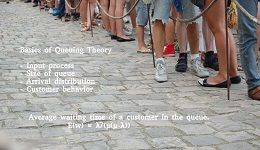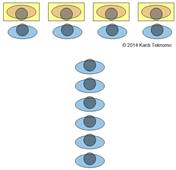This average waiting time in queue calculator is a useful tool for calculating wait times in queues and lines. It can provide an estimated wait time for any given group size and service rate. This calculator can be used to plan ahead when entering queues or lines, as well as for analyzing existing wait times in various scenarios. The calculator accepts inputs of the queue size, the service rate, and the expected arrival rate, and outputs an estimated average wait time.

Table Of Content:
- Queueing theory models calculator.
- Queuing Theory Calculator - Calculator Academy
- Expected waiting time for customers in queue Calculator | Calculate ...
- Basics of queuing theory applied to calculate average waiting time
- Multiple Server Model Calculator - MathCracker.com
- Queueing theory calculator
- Queuing Theory Tutorial - M/M/s Queuing System
- Finding the Average Wait Time: Little's Law — ISSSP for Lean Six ...
- Operations Management Basics: Calculation of the time in the ...
- M/M/1 Calculator and Overview / Amédée d'Aboville / Observable
1. Queueing theory models calculator.
https://www.supositorio.com/rcalc/rcalclite.htm Average number of customers (entities) in the queue. In other words the expected amount of customers waiting to be served. ... Average time spent by a customer ...
Average number of customers (entities) in the queue. In other words the expected amount of customers waiting to be served. ... Average time spent by a customer ...
2. Queuing Theory Calculator - Calculator Academy
https://calculator.academy/queuing-theory-calculator/ Nov 11, 2021 ... ... and service rate of a queue into the calculator to determine the average queue length, average total time, and average waiting time.
Nov 11, 2021 ... ... and service rate of a queue into the calculator to determine the average queue length, average total time, and average waiting time.
3. Expected waiting time for customers in queue Calculator | Calculate ...
https://www.calculatoratoz.com/en/expected-waiting-time-for-customers-in-the-queue-calculator/Calc-2263
To use this online calculator for Expected waiting time for customers in queue, enter Mean arrival rate (λ) & Mean service rate (µ) and hit the calculate button ...
4. Basics of queuing theory applied to calculate average waiting time
https://virtuaq.com/blog/2017-11-23-basics-of-queuing-theory Nov 22, 2017 ... E(m) = ρ2/(1-ρ). m= n-1, being the number of customers in the queue excluding the customer in service. Average length of the nonempty queue. E ...
Nov 22, 2017 ... E(m) = ρ2/(1-ρ). m= n-1, being the number of customers in the queue excluding the customer in service. Average length of the nonempty queue. E ...
5. Multiple Server Model Calculator - MathCracker.com
https://mathcracker.com/multiple-server-model-calculator You can use this Multiple Server Model Calculator, by providing the arrival rate per time period, the service rate per time period, and the number of ...
You can use this Multiple Server Model Calculator, by providing the arrival rate per time period, the service rate per time period, and the number of ...
6. Queueing theory calculator
https://www.stepbystepsolutioncreator.com/pr/multi
This calculator is for doing multiple calculations related to the Multi-server queueing theory. ... It is the average waiting time or delay in queue ...
7. Queuing Theory Tutorial - M/M/s Queuing System
https://people.revoledu.com/kardi/tutorial/Queuing/MMs-Queuing-System.html Use the M/M/s queuing calculator below to experiment and to solve queuing problem ... W = average time a customer spends in the system (in waiting line and ...
Use the M/M/s queuing calculator below to experiment and to solve queuing problem ... W = average time a customer spends in the system (in waiting line and ...
8. Finding the Average Wait Time: Little's Law — ISSSP for Lean Six ...
https://isssp.org/finding-the-average-wait-time-littles-law/ Jul 14, 2019 ... Queuing Theory is the study and analysis of waiting lines and uses mathematics to predict queue lengths and waiting times.
Jul 14, 2019 ... Queuing Theory is the study and analysis of waiting lines and uses mathematics to predict queue lengths and waiting times.
9. Operations Management Basics: Calculation of the time in the ...
https://blogs.sap.com/2015/06/25/operations-management-basics-calculation-of-the-time-in-the-queue-with-multiple-resources/
Jun 25, 2015 ... The time in the queue with multiple resources is calculated as follows: ... How many employees will it take to keep the average waiting time ...
10. M/M/1 Calculator and Overview / Amédée d'Aboville / Observable
https://observablehq.com/@amedeedaboville/m-m-1-calculator-and-overview
Feb 3, 2021 ... The average waiting time will be: 0.25 seconds. The average residence (waiting time + service time): 0.5 seconds. On average, the queue will ...
What does this calculator do?
This calculator provides an estimated average waiting time in any given queue or line based on the inputs of queue size, service rate, and expected arrival rate.
How do I use this calculator?
The user should input the queue size, the service rate (number of customers served per unit of time), and the expected arrival rate (number of customers arriving per unit of time). The calculator will then output an estimated average wait time in that queue or line.
Are there any limitations to this calculator?
This calculator only takes into account basic factors such as queue size, service rate, and expected arrival rate; other variables may affect actual wait times such as variations in customer needs or intensity/duration of services provided.
What type of information does this calculator provide?
This calculator provides an estimated average waiting time based on the inputs provided by the user.
Conclusion:
In conclusion, this average waiting time in queue calculator is a valuable tool for calculating wait times for customers. By providing accurate estimates based on key factors such as queue size, service rate, and expected arrival rates, it can help users accurately plan ahead or analyze existing wait times.
